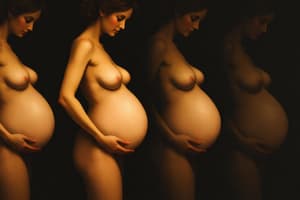Podcast
Questions and Answers
What significant change occurs in the mother's immune system during pregnancy?
What significant change occurs in the mother's immune system during pregnancy?
- It becomes inactive to conserve energy.
- It suppresses to prevent attacking the fetus. (correct)
- It becomes more active to support fetal development.
- It strengthens to protect against infections.
What is a key reason why human gestation is longer compared to other hominins?
What is a key reason why human gestation is longer compared to other hominins?
- To enhance maternal attachment to the offspring.
- To increase the likelihood of survival after birth.
- To build fat stores and body weight in the infant. (correct)
- To allow for larger infant brain development.
How do human infants compare in weight at birth to those of chimpanzees and gorillas?
How do human infants compare in weight at birth to those of chimpanzees and gorillas?
- They weigh significantly less than chimpanzee infants.
- They weigh much more than both chimpanzee and gorilla infants. (correct)
- Their weight is comparable to that of older hominins.
- They weigh about the same as gorilla infants.
What physiological change occurs in mothers during lactation compared to gestation?
What physiological change occurs in mothers during lactation compared to gestation?
What percentage of human infants born at 7.5 months survive?
What percentage of human infants born at 7.5 months survive?
Flashcards
Gestation
Gestation
The process of carrying a developing offspring in the uterus.
Placenta
Placenta
A specialized organ that connects the developing fetus to the mother's uterus and facilitates nutrient and waste exchange.
Immune suppression during pregnancy
Immune suppression during pregnancy
The suppression of the mother's immune system during pregnancy to prevent it from attacking the developing fetus.
Gestational period
Gestational period
Signup and view all the flashcards
Lactation
Lactation
Signup and view all the flashcards
Study Notes
Gestation Overview
- Gestation, the process of carrying developing offspring, has existed for 178 million years.
- It involves a crucial maternal-fetal connection for nourishment and protection.
- The placenta facilitates this connection, with human placentas being highly invasive, allowing direct fetal-maternal blood contact.
- Maternal immune suppression is crucial for preventing the mother's immune system from rejecting the fetus. This is aided by both maternal and fetal factors.
- Immune suppression makes pregnant women more vulnerable to severe illnesses like COVID-19.
Implantation and Birth
- Gestation starts with embryo implantation in the uterus.
- Birth marks the end of gestation and the beginning of lactation.
- Post-birth maternal support (lactation) requires more energy expenditure than pre-birth support.
- The length of gestation is determined by the time needed to prepare the newborn for independent life.
Human Gestation vs. Other Hominins
- Human gestation is longer than other hominin pregnancies, but only slightly.
- The extended gestation period in humans results in greater infant fat stores and body weight at birth.
- Human infants average 6.1% of their mother's weight at birth; whereas chimpanzee and gorilla infants are proportionally smaller, at 3.3% and 2.7% respectively.
- 7.5-month premature human infants have a similar weight to 7.5-month chimpanzee infants. More than 80% of 7.5-month human infants survive.
- The final 6 weeks of human pregnancy dramatically increase infant size through substantial energy transfer from mother to fetus.
Studying That Suits You
Use AI to generate personalized quizzes and flashcards to suit your learning preferences.




